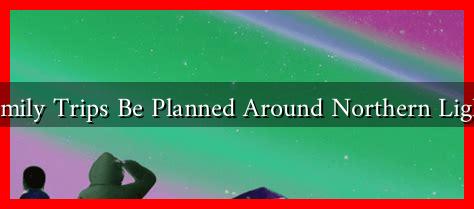-
Table of Contents
How Can Family Trips Be Planned Around Northern Lights Forecasts?
The Northern Lights, or Aurora Borealis, are one of nature’s most breathtaking phenomena, captivating travelers with their vibrant colors and ethereal displays. For families looking to create unforgettable memories, planning a trip around the Northern Lights can be an exhilarating experience. However, to maximize the chances of witnessing this natural wonder, careful planning around Northern Lights forecasts is essential. This article will explore how families can effectively plan their trips to align with the best opportunities for viewing the Northern Lights.
Understanding the Northern Lights
The Northern Lights occur when charged particles from the sun collide with gases in the Earth’s atmosphere, creating stunning displays of light. These lights are most commonly visible in high-latitude regions, such as Norway, Sweden, Finland, Canada, and Alaska.
. The best time to view the Northern Lights is during the winter months, particularly from late September to early April, when the nights are longest and darkest.
Utilizing Northern Lights Forecasts
To plan a successful family trip around the Northern Lights, it is crucial to utilize reliable forecasts. Several resources provide real-time data and predictions for aurora activity:
- Aurora Service: Offers a detailed forecast of aurora activity based on solar wind data.
- Space Weather Live: Provides updates on solar activity and aurora forecasts.
- NOAA’s Space Weather Prediction Center: Features a 3-day aurora forecast and alerts for geomagnetic storms.
By monitoring these forecasts, families can choose the best dates for their trips, increasing the likelihood of witnessing the Northern Lights.
Choosing the Right Location
When planning a family trip, selecting the right location is vital. Some of the best places to view the Northern Lights include:
- Fairbanks, Alaska: Known for its clear skies and frequent aurora activity, Fairbanks offers various family-friendly activities, including dog sledding and hot springs.
- Reykjavik, Iceland: This vibrant city serves as a great base for Northern Lights excursions, with easy access to stunning natural landscapes.
- Tromsø, Norway: Often referred to as the “Gateway to the Arctic,” Tromsø provides numerous tours and activities for families, including whale watching.
Each of these locations offers unique experiences that can enhance a family’s trip while providing ample opportunities to see the Northern Lights.
Timing Your Trip
Timing is crucial when planning a family trip around the Northern Lights. Here are some tips to consider:
- Plan for Winter: The best months for viewing the Northern Lights are typically from December to March, when nights are longest.
- Avoid Full Moons: Bright moonlight can obscure the visibility of the auroras, so check lunar calendars when planning your trip.
- Stay for Several Days: The Northern Lights are unpredictable; staying for a longer period increases your chances of seeing them.
Engaging Activities for Families
While waiting for the Northern Lights to appear, families can engage in various activities that enhance their travel experience:
- Snowshoeing or Cross-Country Skiing: Explore the beautiful winter landscapes while staying active.
- Visit Local Museums: Learn about the culture and history of the region, such as the Aurora Ice Museum in Fairbanks.
- Participate in Cultural Experiences: Engage with local traditions, such as Sami culture in Norway or Inuit culture in Alaska.
Conclusion
Planning a family trip around the Northern Lights can be a rewarding experience filled with adventure and wonder. By utilizing reliable forecasts, choosing the right location, timing the trip appropriately, and engaging in various activities, families can create lasting memories while maximizing their chances of witnessing this spectacular natural phenomenon. With careful planning and a spirit of adventure, the Northern Lights can become a highlight of any family vacation.





